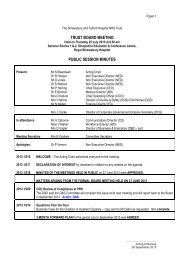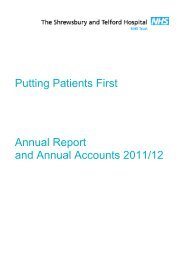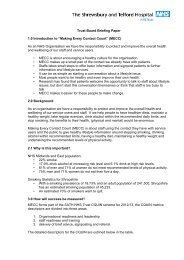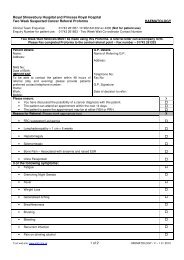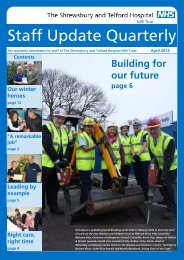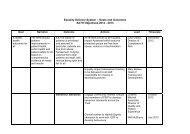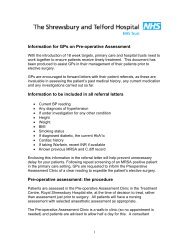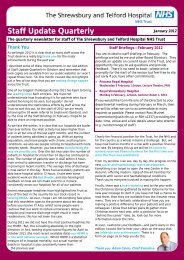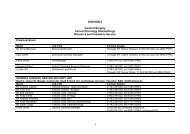1 Annual Report for Safeguarding Children and Vulnerable Adults ...
1 Annual Report for Safeguarding Children and Vulnerable Adults ...
1 Annual Report for Safeguarding Children and Vulnerable Adults ...
You also want an ePaper? Increase the reach of your titles
YUMPU automatically turns print PDFs into web optimized ePapers that Google loves.
The Pentium 4 ArchitectureInteresting Features in Pentium 4• A special trace cache is used to hold predecoded IA-32instructions, which are translated into RISC-likemicrooperations <strong>for</strong> out-of-order execution• Allows up to 126 microoperations to be outst<strong>and</strong>ing indeep-pipelined execution queues, including 48 loads, 24stores, <strong>and</strong> integer <strong>and</strong> floating-point operations over 7functional units, simultaneously.• The FP units also h<strong>and</strong>les the MMX (multimedia extension)ans SSE2 instructions. The functional pipelines executedynamically with multiple issues• Other interesting features include ILP, speculation, registerrenaming, dynamic scheduling <strong>for</strong> OOO execution, <strong>and</strong> inorderretirement, etc.August 29, 2007, Kai Hwang http://GridSec.usc.edu9August 29, 2007, Kai Hwang http://GridSec.usc.edu10Innovative Processor Featuresin Modern Processors:• Use data or instruction prefetching techniques• Use speculative load <strong>and</strong> speculative branchahead of store instructions• Use predicated instruction execution• Use EPIC (Explicit Parallelism InstructionComputing) architecture like the Itanium(IA-64 architecture)Innovative Processor Featuresin Modern Processors:• Compiler optimization from small basicblocks to bigger blocks• Extending compiler from local to globaloptimizations• System In a Chip (SIC) architecture• Chip MultiProcessor (CMP) architectureAugust 29, 2007, Kai Hwang http://GridSec.usc.edu11August 29, 2007, Kai Hwang http://GridSec.usc.edu12
5.5 As previously discussed Shropshire’s Inspection has already taken place<strong>and</strong> there is an expectation that Tel<strong>for</strong>d & Wrekin’s inspection will take placewithin the next few months. The Inspection process is expected to follow thesame processes as <strong>for</strong> the Shropshire Inspection unless governmentchanges.5.6 In line with the VASB policies <strong>and</strong> procedures, including the Association ofDirectors of Adult Social Services (ADASS) <strong>Safeguarding</strong> St<strong>and</strong>ards: Selfassessment, an audit tool has been devised by the Interim Deputy Director ofNursing <strong>and</strong> Quality to specifically review board assurance aroundsafeguarding vulnerable adults systems, governance arrangements, training<strong>and</strong> staffing <strong>and</strong> partnership arrangements in relation to safeguardingvulnerable adults, the audit tool is included in Appendix II. The sameprinciples were applied to this audit as in the Care Quality Commission’sreview of NHS organisation’s compliance against current children’ssafeguarding legislation. An action plan is currently being developed toaddress the gaps identified in the audit, progress will be monitored throughthe local <strong>Safeguarding</strong> Committee.5.7 The West Midl<strong>and</strong>s Quality Review Service have recently undertaken aquality peer review on the care of vulnerable adults in acute hospitals, allpatients in acute hospitals may be vulnerable <strong>and</strong> deserve the highestpossible quality of care. Some groups of patients are, however, particularlyvulnerable <strong>and</strong> may be less able than others to voice their wishes <strong>and</strong> anyconcerns. These groups include people with learning disabilities, mentalhealth problems or dementia, victims of neglect or of sexual or domesticviolence, <strong>and</strong> those people who are particularly frail or nearing the end of theirlife.5.8 The aim of the review was to improve services <strong>for</strong> people throughout theWest Midl<strong>and</strong>s including:• Patients <strong>and</strong> their families <strong>and</strong> carers will know more aboutservices <strong>and</strong> what they can expect.• Commissioners will have better service specifications.• Service providers <strong>and</strong> commissioners will work together toimprove service quality• Quality review visits will give an independent view of servicequality• Reviewers will learn from taking part in review visits.• Good practice will be shared• Service providers <strong>and</strong> commissioners will have betterin<strong>for</strong>mation to give to CQC.5.9 The assessors spent the day in the Trust on the 5 October 2011 reviewingevidence that had been produced in preparation <strong>for</strong> the visit, met with theleads <strong>for</strong> safeguarding <strong>and</strong> improving care, specialist clinical advisors <strong>and</strong> thenominated Executive Lead Director <strong>for</strong> <strong>Safeguarding</strong>. The assessors alsovisited the wards <strong>and</strong> departments <strong>and</strong> were able to talk to staff regarding thecare of vulnerable adults in our care. The results of the inspection will bepublished in November 2011.<strong>Annual</strong> <strong>Safeguarding</strong> <strong>Report</strong> 20114
6.6 Bond Solon a Health Care Legal company has also recently providedMental capacity training within the Trust <strong>for</strong> the newly appointed Centre Chiefs<strong>and</strong> Executive team. It is planned that other senior staff groups will alsoundertake this training in the near future.7. CHILDREN SUBJECT TO A CHILD PROTECTION PLAN7.1 All children who are subject to a child protection plan in Shropshire,Tel<strong>for</strong>d & Wrekin are flagged by the Named Nurse onto the Trust’s patientadministration system (SEMA) There are approximately 300 children withalerts at any one time.7.2 If a child attending either of the Trust’s A&E Departments has a childprotection plan in place, even when there are no safeguarding concerns withthe presentation, a <strong>Safeguarding</strong> <strong>for</strong>m is completed <strong>and</strong> sent to the NamedNurse who then writes to <strong>Children</strong>’s Social Care to advise them of the child’sattendance <strong>for</strong> their records.7.3 All unborn babies who have been made the subject of a child protectionplan are also highlighted on the Trust administration system.8. VULNERABLE ADULT REFERRALS8.1 The table below includes the number of Adult <strong>Safeguarding</strong> referrals thatthe Trust has received in the reporting period April 2010 to March 2011.8.2 83 referrals were instigated by the Trust <strong>and</strong> in the same reporting period20 referrals were made against the Trust.<strong>Report</strong> In<strong>for</strong>mation Adult Protection referralsAdult Protection referrals 1 st April 2010 – 31st March 2011 = 103 (RSH 55 PRH 48)Month Total Instigated by Against the Trust Outcomes against theTrustTrustApril 5 3 2 NS X2May 5 3 2 NS X2June 4 4 0July 8 8 0Aug 9 8 1 NS X1Sept 11 10 1 NS X1Oct 7 7 0Nov 13 11 2 NS X 2Dec 6 5 1 SUB X1Jan 10 7 3 NS X 2 INC X 1Feb 12 7 5 NS X 3 INC X 2March 13 10 3 NS X 2 INC X 1<strong>Annual</strong> <strong>Safeguarding</strong> <strong>Report</strong> 20117
The referral substantiated against the Trust was both concerning discharge planningincluding lack of in<strong>for</strong>mation to relatives/carers <strong>and</strong> external agencies including socialservices <strong>and</strong> care homes. Actions have now been put in place by the ward involvedincluding an improvement in documentation. Transfer letters are now checked by theco-ordinator be<strong>for</strong>e the patients leave the ward <strong>and</strong> a copy is maintained in the patientsmedical records <strong>for</strong> reference. All adult protection referrals against the Trust have beenin the category of Neglect /Omission of care.Key:S = Substantiated (Neglect / Lack of Care)NS = Not SubstantiatedINC = InconclusiveOG = Ongoing investigation8.3 As the Adult <strong>Safeguarding</strong> agenda continues to gather speed at Nationallevel <strong>and</strong> with the continued awareness raising which is happening dailyacross the Trust, it is recognised that further resource is needed to supportthe current adult safeguarding lead to continue to successfully deliver thiscomplex <strong>and</strong> valuable agenda. A recent decision has been made to provideinterim support to the Adult <strong>Safeguarding</strong> Lead <strong>for</strong> a 6 month period whilst areview is undertaken of the service <strong>and</strong> a business plan prepared.9. NEW POLICIES <strong>and</strong> NICE GUIDANCE9.1 During the last 12 months, the following NICE guidance has beenpublished:• CG 89 - When to suspect child maltreatment• CG 115 - Alcohol dependence <strong>and</strong> harmful alcohol use• PH 30 - Preventing unintentional injuries among under 15s in the home9.2 Any NICE guidance that affects children is first presented to the PaediatricGovernance <strong>for</strong> confirmation that SaTH is compliant with any changes whichare required in clinical practice, if they affect safeguarding they are alsopresented to the <strong>Safeguarding</strong> Committee. Copies of CG89 were issued to allwards <strong>for</strong> inclusion in their <strong>Safeguarding</strong> Folder, all Orthopaedic Surgeons<strong>and</strong> Paediatricians were issued with a copy. The guidance is raised <strong>and</strong>shared as part of Group 2 (level 2 <strong>and</strong> above) training.9.3 CG 115 <strong>for</strong>med the basis of the Trust’s alcohol policy. This policy currentlydoes not consider children under the age of eighteen. The Named Nurse isworking with the Matron <strong>for</strong> Emergency services to adapt the policy to adaptthis gap.9.4 As a Public Health policy PH30 does not directly affect hospital staff, butthe newly devised Shropshire Accident Prevention Strategy working groupincludes an Emergency Consultant from RSH as well as the Named Nursewithin the membership. This new strategy will be incorporated into training <strong>for</strong>Group 3 <strong>and</strong> above.<strong>Annual</strong> <strong>Safeguarding</strong> <strong>Report</strong> 20118
9.5 Some policies have required updating in the last year as well as thewriting of some additional new policies. A brief outline is given below:• Self Harm: was updated as part of the recommendations of theShropshire Serious Case Review (SCR).• Domestic Abuse: two policies, one concerning staff who may be thevictims of Domestic Abuse <strong>and</strong> the second policy is to support staffdealing with patients who may be victims.• The Trust’s <strong>Safeguarding</strong> <strong>Children</strong> Policy is due to be updated at theend of 2011 <strong>and</strong> is currently being modified to take into account thenew policies.10. SERIOUS CASE REVIEW AND INTERNAL MANAGEMENT REVIEW10.1 A Serious Case Review (SCR) is required when abuse or neglect of achild has occurred <strong>and</strong> the child has died or has been seriously harmed <strong>and</strong>there is cause <strong>for</strong> concern, as to the way in which multiagency teams haveworked together to protect the child.10.2 Since January 2011 the Trust has been involved in one SCR <strong>and</strong> oneManagement Review. A Management Review is conducted when the criteria<strong>for</strong> a SCR is not met but it is felt by the SCR panel that there are lessons to belearned about how staff in one single agency worked rather than howagencies have worked together. The Management Review was <strong>for</strong> Tel<strong>for</strong>d &Wrekin Local <strong>Safeguarding</strong> <strong>Children</strong> Board (LSCB) <strong>and</strong> the SCR was <strong>for</strong>Shropshire Local <strong>Safeguarding</strong> <strong>Children</strong> Board.10.3 Recommendations from both reviews have been addressed <strong>and</strong> policy<strong>and</strong> practice has changed as a result.11. LOCAL SAFEGUARDING CHILDREN BOARD AND PARTNERSHIPWORKING11.1 The LSCB’s in Shropshire, Tel<strong>for</strong>d <strong>and</strong> Wrekin have the lead role in coordinating<strong>and</strong> improving services to safeguard children <strong>and</strong> young people inour area.The LSCB key responsibilities are to:• Provide the strategic lead in the continued development of Child ProtectionServices• Co-ordinate <strong>and</strong> scrutinise local agency arrangements <strong>for</strong> safeguardingchildren• Ensure the effectiveness of the other agencies’ agreements <strong>for</strong> safeguardingchildren<strong>Annual</strong> <strong>Safeguarding</strong> <strong>Report</strong> 20119
• Ensure that safeguarding is planned within all service developments• Ensure that lessons are learnt from every child’s death <strong>and</strong> serious incident<strong>and</strong> those families are provided with appropriate support when a child dies• Promote safeguarding prevention strategies to minimise the requirement <strong>for</strong>protection.The LSCB has high level membership from all agencies across the localeconomy. The Trust representative on both LSCBs is the Executive Lead <strong>for</strong><strong>Safeguarding</strong>.11.2 Each LSCB has various subgroups which are outlined below:• Serious Case Review Panel• Child Death Overview Panel• Training <strong>and</strong> Development Sub Group• Policy <strong>and</strong> Procedures Sub Group• Domestic Violence ForumMembers of the Trust’s <strong>Safeguarding</strong> <strong>Children</strong> Team are included in themembership of the above groups <strong>and</strong> provide feedback to the Trust’s<strong>Safeguarding</strong> Committee.12. SUMMARYSaTH is fully committed to improving child <strong>and</strong> adult safeguarding processesacross the organisation <strong>and</strong> has a vision to safeguard all children <strong>and</strong>vulnerable adults who may be at risk of harm. Processes are empowering <strong>and</strong>person centred, preventative <strong>and</strong> holistic <strong>and</strong> we will continue to deliver thesafeguarding agenda encompassing a multi agency <strong>and</strong> partnershipapproach. The governance arrangements <strong>for</strong> child <strong>and</strong> adult safeguarding willbe more robust <strong>and</strong> systems will be put into place to allow <strong>for</strong> effectivemonitoring <strong>and</strong> assessment of compliance against locally agreed policies <strong>and</strong>guidelines.Shrewsbury <strong>and</strong> Tel<strong>for</strong>d Hospital (SaTH) continues to work hard in developingprocesses <strong>and</strong> systems that ensure that people using the service, staff <strong>and</strong>others who visit the hospital are as safe as they can be <strong>and</strong> that risks areeffectively managed.As professionals we will continue to deliver the Child <strong>and</strong> <strong>Vulnerable</strong> Adult<strong>Safeguarding</strong> agenda, encompassing a multi-agency <strong>and</strong> partnershipapproach. The Governance arrangements <strong>for</strong> <strong>Children</strong>’s <strong>and</strong> <strong>Adults</strong><strong>Safeguarding</strong> will be more robust with improved Level 1 training coverage <strong>and</strong>systems will be put in place to allow <strong>for</strong> effective monitoring <strong>and</strong> assessmentof compliance against locally agreed Policies <strong>and</strong> Guidelines within ClinicalCentres.<strong>Annual</strong> <strong>Safeguarding</strong> <strong>Report</strong> 201110
The known influences <strong>and</strong> policy drivers that are likely to be the focus of thesafeguarding team <strong>for</strong> the <strong>for</strong>thcoming year are described below:To continue to provide attendance at LSCB sub-groups <strong>and</strong> the HealthGovernance <strong>Safeguarding</strong> Group <strong>and</strong> develop practices, <strong>and</strong>contributing to the development of a multi agency training strategy <strong>and</strong>procedures.To continue to provide in-house local guidance to compliment LSCBprocedures, protocols <strong>and</strong> practice guidelines.To ensure that SaTH continues to adhere to the recommendations <strong>for</strong>staff training in child protection procedures.Continue communication between the Shropshire Community Trust<strong>and</strong> the Acute servicesTo participate in Child Death Overview Panels.To maintain the existence of the <strong>Safeguarding</strong> Steering Group <strong>for</strong>medin response to Lord Laming’s recommendations in 2003.To continue to work with the Human Resource department in ensuringCRB checks <strong>and</strong> “Managing Allegations against Staff” policy <strong>and</strong>processes are adhered toTo continue to ensure that staff adhere to the training programme,including child <strong>and</strong> adult protection awareness, Mental Capacity Act<strong>and</strong> the Deprivation of Liberty Safeguards.Continue to engage with people at risk of abuse, their family, carers,relatives <strong>and</strong> external agencies.<strong>Annual</strong> <strong>Safeguarding</strong> <strong>Report</strong> 201111
Appendix IMUNRO RECOMMENDATIONS GOVERNMENTRESPONSERecommendation 1:Initial <strong>and</strong> core assessmentsshould be scrapped <strong>and</strong>replaced with a single, ongoingassessment listing decisions tobe made.Accepted1 )The government willmake full revision ofWorking Together toSafeguard <strong>Children</strong> <strong>and</strong> TheFramework <strong>for</strong> theAssessment of <strong>Children</strong> inNeed <strong>and</strong> their Families.TIMELINE1) By July 20122) By December 2011Recommendation 2:Unannounced inspectionsshould examine thesafeguarding per<strong>for</strong>mance ofother agencies as well aschildren's services.2) The government willimplement an interimamendment to WorkingTogether to Safeguard<strong>Children</strong> to removeassessment deadlines <strong>and</strong>the distinction between initial<strong>and</strong> core assessments.AcceptedOfsted intends to have anew local authorityinspection framework inplace, following aconsultation in July 2011.By May 2012Recommendation 3:Inspections should also look atoutcomes <strong>and</strong> how children'swishes <strong>and</strong> experiences shapeservices provided.AcceptedOfsted intends to have anew local authorityinspection framework inplace, following aconsultation in July 2011.By May 2012Recommendation 4:A combination of nationallycollected <strong>and</strong> locally publishedper<strong>for</strong>mance data should beused.Accepted1) The government willconfirm what will be on thelist of locally publishedper<strong>for</strong>mance in<strong>for</strong>mation.2) The government is aiming<strong>for</strong> publication of the suite ofnew nationally collectedper<strong>for</strong>mance in<strong>for</strong>mation.1) By December 20112) By May 2012<strong>Annual</strong> <strong>Safeguarding</strong> <strong>Report</strong> 201112
Recommendation 5:Each Local <strong>Safeguarding</strong><strong>Children</strong> Board (LSCB) shouldsubmit an annual report to theChief Executive <strong>and</strong> Leader ofthe Council, <strong>and</strong> (subject tolegislation) to the local Police<strong>and</strong> Crime Commissioner <strong>and</strong>the Chair of the health <strong>and</strong>wellbeing board.AcceptedThe government will identifythe appropriate legislativevehicle.As soon as practicableRecommendation 6:Local safeguarding childrenboards should assess localoutcomes, including theeffectiveness <strong>and</strong> value <strong>for</strong>money of early interventionservices <strong>and</strong> multi-agencytraining.Recommendation 7:The role of the director ofchildren's services <strong>and</strong> the leadmember <strong>for</strong> children's servicesshould be protected fromdepartmental mergers.Recommendation 8:Research is needed on theimpact of health re<strong>for</strong>ms onpartnership working in childprotection.Recommendation 9:LSCBs should use a systemsapproach to serious casereviews (SCRs) <strong>and</strong> Ofsted’sevaluation of SCRs should end.Accepted in principleThe government will publishan amendment to WorkingTogether to Safeguard<strong>Children</strong> regarding the roleof local safeguardingchildren boards inmonitoring effectiveness ofearly help <strong>and</strong> protectiveservices.Accepted in principleThe government will consult<strong>for</strong>mally on revised statutoryguidance on the director ofchildren's services (DCS)role <strong>and</strong> the lead member.Accepted in principleThe Department of Health<strong>and</strong> the Department <strong>for</strong>Education will work withNHS bodies, localauthorities, professionalbodies <strong>and</strong> practitioners topublish a joint programme ofwork.Further considerationneededThe government willconsider evidence <strong>and</strong>opportunities <strong>for</strong> usingsystems reviewmethodologies <strong>for</strong> SCRs<strong>and</strong> options <strong>for</strong> developingthe national resourcesrecommended.By December 2011By autumn 2011By September 2011Second half of 2011<strong>Annual</strong> <strong>Safeguarding</strong> <strong>Report</strong> 201113
Recommendation 10:Councils should have a legalduty to provide enough earlyintervention services.Recommendation 11:The Social Work Re<strong>for</strong>m Board'sprofessional capabilitiesframework should specify thosequalities needed <strong>for</strong> child <strong>and</strong>family social work.Recommendation 12:Employers <strong>and</strong> higher educationinstitutions should work togetheron student placements.Accepted in principleThe government will decidewhether there should be astatutory duty <strong>for</strong> localauthorities in relation toearly intervention <strong>and</strong>, if so,what <strong>for</strong>m it will take.AcceptedThe professional capabilitiesframework <strong>and</strong> CPDframework, developed bythe Social Work Re<strong>for</strong>mBoard, will include childspecific skills <strong>and</strong> learning<strong>and</strong> be implemented.Accepted1 ) The government expectsthe College of Social Workto develop plans <strong>for</strong>designated approvedpractice settings <strong>and</strong>teaching organisation status<strong>and</strong> to consider the merits ofstudent units.By September 2011By autumn 20121) By December 20122) By summer 2012Recommendation 13:Local authorities should review<strong>and</strong> redesign the ways in whichchild <strong>and</strong> family social work isdelivered, drawing on evidenceof effective interventions <strong>and</strong>helping social workers useevidence based practice.2) The government will buildpartnership arrangementswith employers <strong>and</strong> highereducation institutions.AcceptedLocal leaders will undertakeself-assessment,considering whether child<strong>and</strong> family social workservices are appropriatelyconfigured so that they meetthe needs of children <strong>and</strong>familiesAt a locally determinedpace<strong>Annual</strong> <strong>Safeguarding</strong> <strong>Report</strong> 201114
Recommendation 14:Local authorities shoulddesignate a principal child <strong>and</strong>family social worker.Accepted1) The government expectsmost local authorities tohave chosen to designate aprincipal child <strong>and</strong> familysocial worker.1) By April 20122) By July 2012Recommendation 15:A chief social worker should becreated in government.2) The government expectsthat all local authorities "willhave chosen" to designate aprincipal child <strong>and</strong> familysocial worker.Accepted in principleThe government plans <strong>for</strong> achief social worker tooversee children's <strong>and</strong>adults' services to beimplemented.By late 2012<strong>Annual</strong> <strong>Safeguarding</strong> <strong>Report</strong> 201115
APPENDIX II1. SHREWSBURY AND TELFORD NHS HOSPITAL (SATH) MEETS STATUTORYREQUIREMENTS IN RELATION TO CRIMINAL BUREAU CHECKSIDENTIFY LEVEL OF COMPLIANCE BY PLACING A TICK IN THE CORRESPONDING BOX &PROVIDE RELEVANT EVIDENCE1.1 All staff working with vulnerable adults have an enhanced Criminal Records Bureau(CRB) disclosure.Fully compliantNON – COMPLIANT BUT WORKINGTOWARDS STANDARD (GIVE % OF STAFFWORKING WITH VULNERABLE ADULTSWITH ENHANCED CRB AND OUTLINEACTIONS BEING TAKEN)Non compliant <strong>and</strong> no plans in place toachieve st<strong>and</strong>ard (give % of staff working withvulnerable adults with enhanced CRB)Human Resources CRB check policy no.34Section 6.5 – requires reviewPolicy <strong>and</strong> guidelines attached1.2 All staff with access to persons in receipt of health services in the course of theirnormal duties to have a st<strong>and</strong>ard CRB disclosure.Fully compliantNon – compliant but working towards st<strong>and</strong>ard(give % of staff with access to persons inreceipt of health services having had ast<strong>and</strong>ard CRB; outline actions to be taken toachieve st<strong>and</strong>ard)Non compliant <strong>and</strong> no plans in place toachieve st<strong>and</strong>ard (give % of staff with accessto persons in receipt of health services havinghad a st<strong>and</strong>ard CRB)The Trust does not use a st<strong>and</strong>ard CRBdisclosure <strong>for</strong> staff only enhanced. There isno expiry on the CRB <strong>and</strong> have spoken toHR, a new enhanced CRB would berequested if a member of staff waspromoted or a change in their roleWill be taken <strong>for</strong>ward with HR as part ofaction plan2. VUNERABLE ADULTS PROTECTION POLICIES AND SYSTEMS ARE UP TO DATE ANDROBUSTIDENTIFY LEVEL OF COMPLIANCE BY PLACING A TICK IN THE CORRESPONDING BOX &PROVIDE RELEVANT EVIDENCE2.1 There is a system <strong>for</strong> flagging vulnerable adults <strong>for</strong> whom there are safeguardingconcernsFully compliant – system in place (describesystem)No system currently in place but action planbeing developedPolicy <strong>and</strong> procedure available on SATHintranet section 8.5 also a referral<strong>for</strong>m(appendix 2)<strong>Annual</strong> <strong>Safeguarding</strong> <strong>Report</strong> 201116
No system <strong>and</strong> no plans in placeFlowchart has been developed withguidance from West Mercia Police –adultprotection <strong>and</strong> adult protection ShropshireCouncil (attached)Adult protection policy including referralattached.(appendix 2)2.2. ALL STAFF ARE MADE AWARE OF SAFEGUARDING VULNERABLE ADULTS POLICIESAND PROCEDURES FOR SHROPSHIRE, TELFORD AND WREKINFULLY COMPLIANT: DESCRIBE HOWSTAFF ARE MADE AWARE OF AND HAVEACCESS TO POLICIES ANDPROCEDURES; OUTCOMES FROM ANYAUDITS ON ADULT PROTECTIONPROCEDURES ETCNon compliant but action plan in place toensure st<strong>and</strong>ard met; outline processes to beput in place.Non compliant <strong>and</strong> no plans in place.Procedure is included in the AdultProtection training. ( Statutory <strong>for</strong> all patienth<strong>and</strong>lers)2.3 <strong>Safeguarding</strong> <strong>Vulnerable</strong> <strong>Adults</strong> Policy & Procedures (or set of policies <strong>and</strong>procedures) include a process <strong>for</strong> following up referrals to adults social careFully compliant: provide an up to date versionof the policy/ procedure (where it <strong>for</strong>ms part ofa wider policy please identify the relevantsection in red.)Non- compliant but policy/procedure in processof being developedNon compliant: no plans in place to developguidanceAll adult protection referrals are directed tothe relevant social services, which in turnhave a strategy discussion with the police.A decision is then made as to who will leadthe investigation -sections 8.6 <strong>and</strong> 8.7 ofthe AP policy2.4 <strong>Safeguarding</strong> <strong>Vulnerable</strong> <strong>Adults</strong> Policy (or set of policies <strong>and</strong> procedures) includes aprocess <strong>for</strong> dealing with vulnerable adults who are at risk from domestic abuse, physical,sexual, verbal or psychological abuse <strong>and</strong> has a clearly defined process <strong>for</strong> recognising/acting on concernFully compliant: provide an up to date versionof the policy/ procedure (where it <strong>for</strong>ms part ofa wider policy please identify the relevantsection in red.)Non- compliant but policy/procedure in processof being developedNon compliant: no plans in place to developguidanceSATH policy Section 7 <strong>and</strong> 9 of the APpolicyAP policy <strong>for</strong> SATH is in line with the multiagencypolicy <strong>for</strong> Shropshire <strong>and</strong> Tel<strong>for</strong>d<strong>and</strong> Wrekin. For review 2012<strong>Annual</strong> <strong>Safeguarding</strong> <strong>Report</strong> 201117
2.5 <strong>Safeguarding</strong> <strong>Vulnerable</strong> <strong>Adults</strong> Policy (or set of policies <strong>and</strong> procedures) includes aprocess <strong>for</strong> ensuring that all patients are routinely asked about any caring responsibilitiesFully compliant: provide an up to date versionof the policy/ procedure (where it <strong>for</strong>ms part ofa wider policy please identify the relevantsection in red.)Non- compliant but policy/procedure in processof being developedNon compliant: no plans in place to developguidanceAdmission documentation ( PatientDemographics Document) page 2 includeshome circumstances <strong>and</strong> page 6 section13.2 is a screening tool <strong>for</strong> a Social Workreferral2.6 <strong>Safeguarding</strong> <strong>Vulnerable</strong> <strong>Adults</strong> Policy (or set of policies <strong>and</strong> procedures) includes aprocess <strong>for</strong> following up vulnerable adults who miss outpatient appointmentsFully compliant: provide an up to date versionof the policy/ procedure (where it <strong>for</strong>ms part ofa wider policy please identify the relevantsection in red.)Non- compliant but policy/procedure in processof being developedNon compliant: no plans in place to developguidanceThis will <strong>for</strong>m part of action plan <strong>and</strong>discussions will commence with VASB2.7 <strong>Safeguarding</strong> <strong>Vulnerable</strong> <strong>Adults</strong> Policy (or set of policies <strong>and</strong> procedures) include aprocess <strong>for</strong> h<strong>and</strong>ling suspected fabricated induced illnessFully compliant: provide an up to date versionof the policy/ procedureNon-compliant but policy/procedure in processof being developedNon compliant: no plans in place to developguidanceThis will <strong>for</strong>m part of action plan <strong>and</strong>discussions will commence with VASB2.8 <strong>Safeguarding</strong> <strong>Vulnerable</strong> <strong>Adults</strong> Policy (or set of policies <strong>and</strong> procedures) includesclear guidance on managing allegations against staff <strong>and</strong> volunteers working withvulnerable adults in line with national <strong>and</strong> local safeguarding board guidanceFully compliant: provide an up to date versionof the policy/ procedureNon- compliant but policy/procedure in processof being developedNon compliant: no plans in place to developguidanceAP policy attached section 11, <strong>and</strong> 11.1Whistle blowing policy HR05 section 1.2Disciplinary procedure attachedFollowing the Adult Protection process, <strong>and</strong>discussion with senior members of staff<strong>and</strong> also to include Whistle blowing policyHR05 section 1.2<strong>Annual</strong> <strong>Safeguarding</strong> <strong>Report</strong> 201118
2.9 <strong>Safeguarding</strong> <strong>Vulnerable</strong> <strong>Adults</strong> Policy (or set of policies <strong>and</strong> procedures) includesclear guidance on how to respond to a disclosure from a vulnerable adult, which includesa confidentiality policy <strong>and</strong> procedureFully compliant: provide an up to date versionof the policy/ procedure (where it <strong>for</strong>ms part ofa wider policy please identify the relevantsection in red.)Non- compliant but in process of beingdevelopedNon compliant: no plans in place to developguidanceSATH adult protection policy <strong>and</strong>procedures includes confidentiality section122.10 <strong>Safeguarding</strong> <strong>Vulnerable</strong> <strong>Adults</strong> Policy (or set of policies <strong>and</strong> procedures) include aprocess <strong>for</strong> resolving cases where health professionals have a difference of opinionFully compliant: provide an up to date versionof the policy/ procedure (where it <strong>for</strong>ms part ofa wider policy please identify the relevantsection in red.)Non- compliant but in process of beingdevelopedNon compliant: no plans in place to developguidanceSATH adult protection policySection 102.11 Relevant to walk-in centres: <strong>Vulnerable</strong> Adult policy (or set of policies <strong>and</strong>procedures) includes a process or protocol that outlines when walk-in centre staff shouldcheck whether a vulnerable adult is subject to a vulnerable adults protection planFully compliant: provide an up to date versionof the policy/ procedure (where it <strong>for</strong>ms part ofa wider policy please identify the relevantsection in red.)Non- compliant but policy/procedure in processof being developedNon compliant: no plans in place to developguidanceNA3. TRAININGIDENTIFY LEVEL OF COMPLIANCE BY PLACING A TICK IN THE CORRESPONDING BOX &PROVIDE RELEVANT EVIDENCE3.1 All eligible staff have undertaken <strong>and</strong> are up to date with safeguarding training at level1. (Level 1 training aims to ensure all clinical <strong>and</strong> non clinical staff underst<strong>and</strong> whatconstitutes vulnerable adult abuse <strong>and</strong> know what to do if they have concerns a adult isbeing abused)<strong>Annual</strong> <strong>Safeguarding</strong> <strong>Report</strong> 201119
Fully compliant; all clinical <strong>and</strong> non clinical staffhave accessed level 1 training within last threeyears; provide evidence of training plans <strong>and</strong>copy of safeguarding training strategyNon compliant but action plan in place: state %of work<strong>for</strong>ce (clinical <strong>and</strong> non clinical) havingaccessed level 1 training within last 3 years<strong>and</strong> provide copy of training strategy <strong>and</strong>outline action to be takenNon compliant – no action plans / trainingstrategy in placeAll patient h<strong>and</strong>lers to attend adultprotection training (statutory E course)Training numbers March 2010 – 2011 =43%Adult protection training is part of statutorytraining. 1672 members of staff (patienth<strong>and</strong>lers trained) We currently have 3486members of staff who are patient h<strong>and</strong>lersTraining outline attached3.2 Is the Trust planning to undertake a review of its training arrangements within the next6 months to ensure they take account of emerging messages from the national review ofadult safeguardingYes Training reviewed annually by Training <strong>and</strong> Development Manager<strong>Annual</strong> <strong>Safeguarding</strong> <strong>Report</strong> 201120



